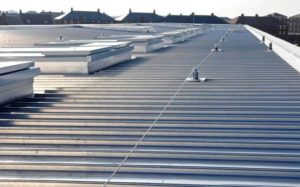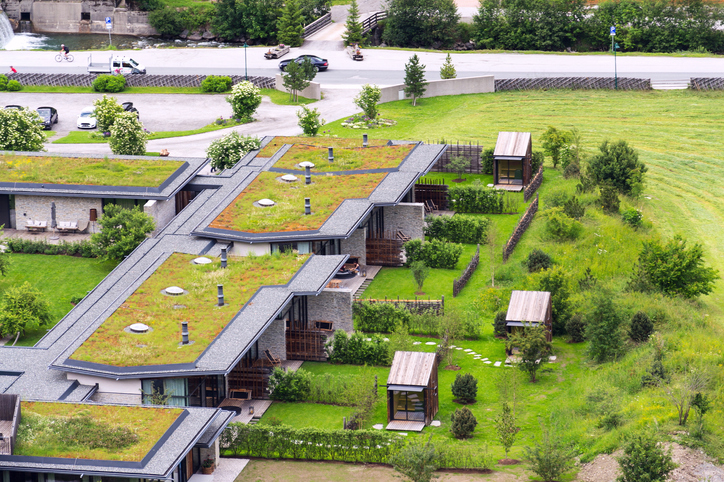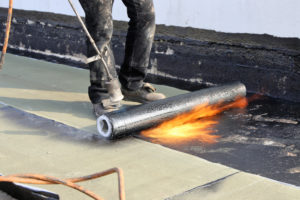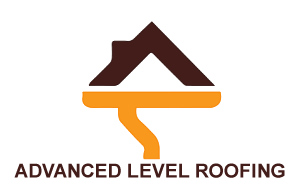There is not one type of flat roofing system that works as the “default standard” for flat roofs everywhere – different structures have different demands on their roofing system. In this blog post, we go through the top four most common flat (AKA: low slope) roofing system choices found in Calgary today.
The Lowdown on Flat Roofing
The popularity of having a flat roof seems to be increasing – especially in large cities like Toronto and Vancouver, and even right here in beautiful Calgary. There are a number of reasons why commercial property owners and homeowners alike are choosing to install a flat roofing system, including (but not limited to):
-
-
- Flat roofs typically cost less to install than traditional sloped roofing
- Ease of maintenance and access that low slope roofing offers
- Optimization of space (both indoors and out)
- Aesthetic appeal
-
Whatever your reason for wanting a flat roof, it’s useful to know just what you’re getting into before taking the plunge. Read on to learn about the different materials used for various flat roofing systems, their average life-spans, and the type of flat roofs each system is best suited for.
Flat Roofing Systems & Materials

When it comes to roofing, there is no “default standard” or “one-size fits all” solution. This is because every structure is different – different size, different purpose, different climates, and so on.
With this in mind, it’s no surprise that flat roofers have a variety of different options when it comes to appropriate materials for a flat roof. These options include TPO roofing systems, the environmentally friendly EDPM system, SBS torch on, and BUR membrane roofing systems.
Here’s an easy-to-digest rundown of these four most popular flat roofing systems:
TPO (short for “thermoplastic polyolefin”) roofing systems:
Thermoplastic polyolefin – TPO – is a form of single-ply membrane that is most commonly used in commercial flat roofing. TPO is a comparatively recent material to the roofing industry (first introduced just under 30 years ago, in the early 1990s), but it’s already proven itself to be a strong option. Right now, given TPO’s relative newness to the roofing industry, its life-span is considered to be between 25-30 years.
TPO is an easily installed, economical, UV- and heat-resistant material. TPO roofing sections are easy to transport and then weld together, making it an increasingly popular choice for large-area commercial flat roofing projects. TPO’s durability also makes it a good flat roofing material, as it’s resistant to mould growth, dirt build up, tears, and punctures.
However, TPO may not be the best choice for climates that are hot & sunny year-round. This is because perpetually intense solar loading can cause TPO to undergo membrane curing & cracking. However, in climates like here in Calgary, TPO is a viable candidate for certain commercial building roofing systems.
If TPO roofing is an option you’re looking into and you want more information about the types of commercial structures that benefit most from having a TPO roof then feel free to give us a call or drop us a line.
EDPM (“ethylene propylene diene terpolymer”) roofing systems:
EDPM is an incredibly resilient synthetic rubber that is a pretty popular choice for lots of roofing systems – including low-slope/flat roofing – across the globe. It can also be attached to your flat roof using a few different methods, making it a versatile material that can suit a variety of flat roofing installations.
Much like TPO, EDPM is affordable, as well as UV- and heat-resistant. It’s also highly resistant to wind damage, making it a strong choice for windy climates (such as Lethbridge, for example). However, unlike TPO, EDPM has been on the market for nearly 50 years now, which makes it a very established and time-tested material.
Many folks prefer to use EDPM because it’s among the most eco-friendly roofing choices commonly available. Not only is it one of the longest lasting roofing materials on the market today – it’s also a low-energy consumption material to install, 100% recyclable, and widely used as the waterproof membrane of choice for green roof (AKA: living roof) installations.
Furthermore, these roofs have a very long life-span. In fact, there are anecdotes of EDPM roofs installed in the 1970s that are still fully functional today!

These green living roofs are good examples of what a properly installed EDPM roofing system is capable of supporting in modern, low-maintenance residential applications.
SBS torch on roofing:
Also referred to as “modified bitumen roofing”, this type of roofing material is made of rubber-enhanced bitumen. The addition of rubber makes this roofing material more elastic than normal bitumen, as well as improving its capacity to withstand more dramatic shifts in temperature.

Just like the name implies, “modified bitumen” SBS torch on roofing systems typically have to be “torched on” and last around 15-20 years.
SBS torch on roofing is known for its good waterproofing and insulation capabilities, and is rated for use with fireplaces. It’s also rated for its durability against hail and wind.
However, SBS torch on roofing has a limited life-span, especially when compared with EDPM; the average life-expectancy of modified bitumen roofing is between 15-20 years.
BUR roofing systems:
Built up roof membrane systems (AKA: BUR systems or “tar & gravel roofs”) are among the oldest roofing systems still in use today. BUR membrane systems typically use alternating layers of roofing felts/ply sheets and asphalt or coal tar. The top layer of BUR systems can be any number of materials, though gravel is definitely one of the most popular surfacing materials.
The typical life-span of a BUR system is 15-30 years, depending on the materials used and the climate it’s shielding against.
In Calgary, the vast majority of our commercial downtown flat-roofed buildings once had these traditional BUR systems and we still come across quite a few in the course of our work of roofing Calgary. However, it’s worth noting that there’s a definite increase in the number of Alberta buildings that are replacing their old roofing systems with those that support a living green roof, roofs that accommodate solar panels, and other more eco-sustainable solutions. Programs like Energy Efficiency Alberta (which, as of Oct. 2019, no longer accepts applications) helped spur this movement by offering incentives for property owners to “go more green”.
Here at Advanced Level Roofing, we’ve helped hundreds of homeowners and commercial landlords upgrade their old roofing systems. We know what systems can and should be upgraded, as well as what roofing systems can or should not. We want our clients to get the best value for their dollars, both now and throughout the life of their roofing systems. Ask one of our roofing experts about what’s possible for your low-slope roof and we’ll be happy to give you the straight-up lowdown on what your flat roofing options are – we’ve got you covered!
Whatever your flat roofing needs are, Advanced Level Roofing has the skill and practical expertise to take your flat roof to the next level. We work hard to be Calgary’s most trusted roofing company for homeowners and business owners alike. Add to that our expertise with low-slope roofing and it means you know you can rely on us to install or repair your flat roof so that stands the test of time and Calgary weather. Don’t gamble with the ROI of your next roofing project – chat with one of our Calgary roofing experts and we’ll help you understand the best roof for your needs.
Founded & headquartered in Calgary, Advanced Level Roofing is now incredibly proud to offer our professional services for:
• Calgary roofing • Edmonton roofing • Kelowna roofing • Winnipeg roofing



Recent Comments